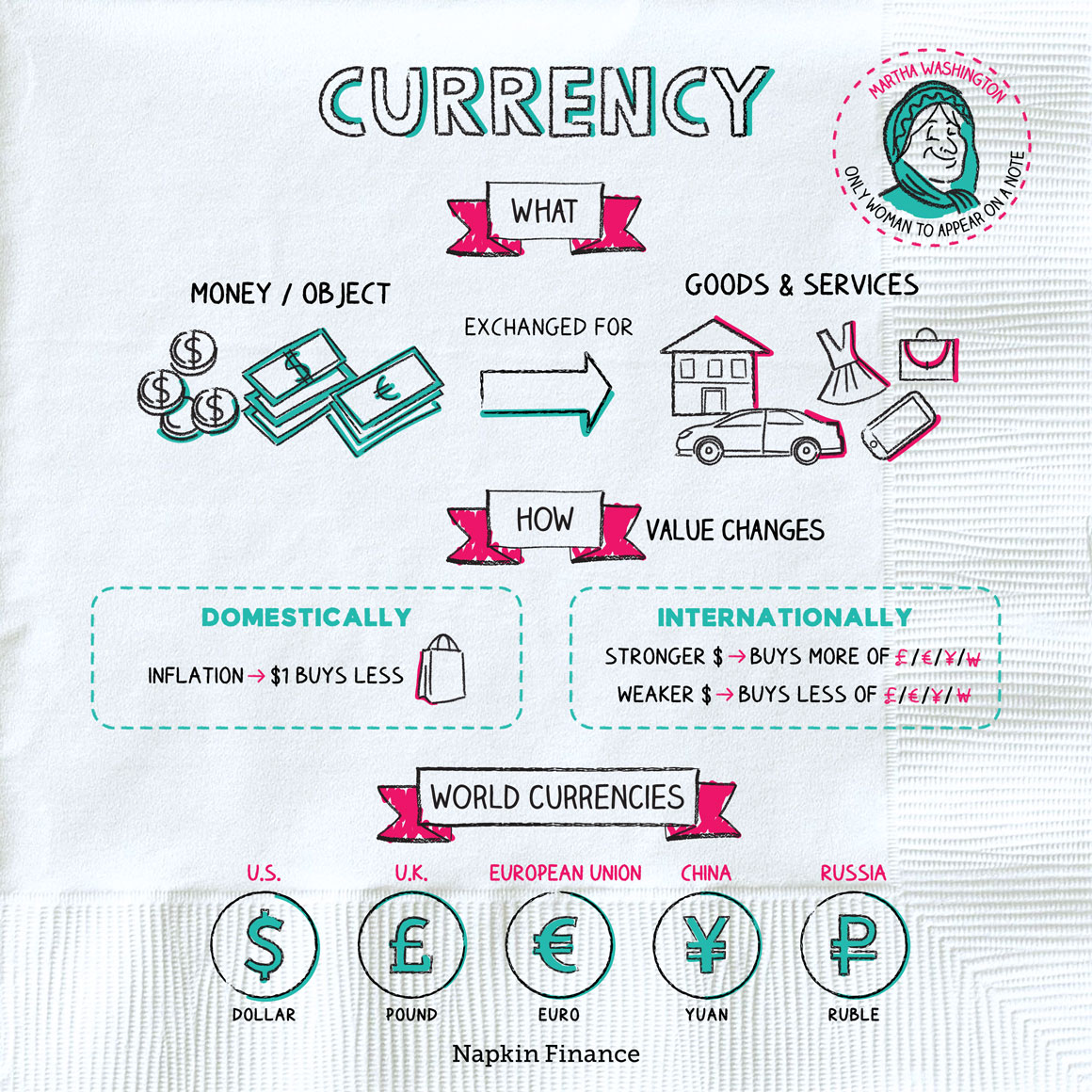Currency
All About the Benjamins
Currency is anything that people use to store value or trade for goods or services. Currency can be paper and coins, such as dollars and cents, or even an object, such as beads.
Typically, currencies are controlled by a government. There are 180 different well-established currencies used around the world today. That number gets much larger if you include controversial forms of money, such as cryptocurrency (which not everyone agrees truly counts as a form of currency).
Unlike gold or diamonds—which have value because they are scarce resources—currency has value even though it’s not made of anything particularly special.
There are lots of theories about why currency has value—or if it truly does. The basic explanation is that currency has value because we say it does—and we say it does because it makes our lives easier.
The upside of currency is that it makes it easier to buy and sell a wide variety of goods, to save for later spending, or to blow your whole paycheck in an evening of online shopping.
The downside of currency is that in times of extreme political or economic turmoil people may start to doubt that a particular currency has value, which can lead to an economic crisis.
Although $1 will always be worth $1, currency can lose (or gain) in value compared with other items.
Currency values can change in two ways:
- Domestically
- The value of $1 decreases over time due to inflation, which occurs when prices rise.
- Inflation means that over time $1 buys less in goods and services.
- Internationally
- The value of one currency relative to another is called an “exchange rate.”
- If $1 buys you £0.75 today but buys you £2 in five years, then the dollar has gained in value relative to the pound (because you can buy more with it).
Factors that influence currency values can include:
- Inflation
- Interest rates around the world
- Economic growth
- Government debt
- Politics
- Imports and exports
- Prices of commodities, such as oil
- Trading activity by currency investors
For the most part, every country has its own currency.
The Euro is an exception—it is the official currency of the Eurozone, which consists of 19 of the 28 member states of the European Union. And some non-U.S. countries use the U.S. dollar as their official currency, including Ecuador and El Salvador.
Some of the major global currencies include:
| Country | Currency | Symbol |
| Brazil | Real | R$ |
| China | Yuan | ¥ |
| India | Rupee | Rp |
| Israel | Shekel | ₪ |
| Italy | Euro | € |
| Japan | Yen | ¥ |
Cryptocurrencies are virtual currencies not issued by a government or other central authority. Cryptocurrencies exist only online, so they typically can’t be used to buy your morning coffee or fill up your gas tank. But the number and range of businesses that accept crypto as payment is growing.
Cryptocurrency is controversial—some people feel that it is as bona fide (or more) of a currency as the U.S. dollar. Others believe it’s closer to Monopoly money. Whether or not cryptocurrency moves further into the mainstream will depend on if more people start to agree that it has value.
If we didn’t have currency, society would probably function on a barter system, in which people could trade one good or service for another. For example, a farmer and a tailor could trade a bushel of wheat for a shirt.
Additionally, throughout history a number of different items have been used as “commodity currencies,” such as:
- Salt
- Soap
- Cocoa
- Beans
- Tea
- Tobacco
- Seashells
- Feathers
- Cattle
- Cigarettes
Currency can be anything that stores value and is used in exchange for goods and services. Although mainstream currencies are generally issued by governments, there are also alternative currencies, such as commodity currencies and cryptocurrency.
- The largest U.S. note ever in circulation was the $10,000 bill, which was issued until 1945. Fewer than 350 of these bills are in circulation today.
- Martha Washington is the only woman whose portrait has appeared on a U.S. currency note. She appeared on the face of the $1 Silver Certificate of 1886 and 1891.
- In 2016 plans were announced to put Harriet Tubman on the $20 bill. However, the change was later put on indefinite delay, along with the previously approved addition of Martin Luther King, Jr. to the $5 bill.
- Currency is anything that society at large agrees has value and can be used to buy and sell things.
- Currency can exist as paper, coins, gold, beads, lines of computer code, and more.
- Although $1 will always be worth $1 and £1 will always be worth £1, currency can gain or lose value compared with other items.
- People agree that currency has value because it makes our lives easier to do so.




